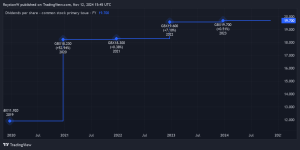National Grid (LSE: NG.) shares have long been popular with dividend seekers. The firm’s monopoly status in power transmission ensures consistent demand while its regulated revenue leads to stable income.
The FTSE 100 stock currently carries a forward-looking dividend yield of 5.4%. How much income could that generate from a £20k investment? Let’s find out.
Rights issue
Firstly though, any notion that National Grid is a steady plodder throwing off rising dividends till the end of time was shattered in May. The share price tanked almost 20% in the days following a £7bn rights issue.
This gave shareholders like myself the right to buy more shares at a lower price, specifically seven new shares for every 24 held.
The firm announced: “Net proceeds…will principally be utilised to fund a higher growth investment phase for the Group, with around £60bn of capital investment expected during the 5-year period from FY25 to FY29.”
This is expected to drive underlying earnings per share growth of 6% to 8% over this period.
Income potential
One consequence of this increase in shares is that the dividend has been rebased. This puts the forward yield at 5.4%, down from 6.6%.
So, how much could £20k earn back in passive income now? Well, on a 5.4% yield, the stock could generate £1,080 in annual dividends.
That’s better than the FTSE 100 average and broadly in line with other utilities. But there are over 10 Footsie shares currently with higher yields. I wouldn’t invest £20k into the stock.
Ballooning debt
Like many stock-pickers, I keep notes on all my investments. These contain the reasons why I’m invested, with the sort of returns I’m hoping for if things pan out well. Key risks are highlighted to keep an eye on.
The obvious risk with National Grid is its colossal debt pile. This has been rising dramatically in recent years as it builds new infrastructure, pays interest, and invests to decarbonise the energy network.
In fact, net debt has risen from £26.5bn in FY18 to £42.8bn in FY24 (which ended in March). To be honest, I can only see it going higher over time.
For context, this planned £60bn in capital spending over the next few years will be more than double what the utility giant spent over the last five years.
One positive is that the firm does still have assets to sell. It’s intending to offload its UK liquefied natural gas (LNG) facility and US onshore renewables operation. But once it becomes a pure-play networks business, what can it sell then? Further cash raises and even dividend cuts are a possibility at some point.
What I’m doing
Following the rights issue, many brokers have been busy readjusting their share price targets. Currently, the consensus one-year target is 1,102p, which is 24% above today’s price of 887p.
Of course, the shares may never reach such a price. But given this noticeably higher target, I’ll let the dust settle and see how things play out. I haven’t bought more shares and am very unlikely to do so.
Overall, I’m relieved the share price is still up over five years. Investors have had a good run of payouts, even through the pandemic. But I think there are far better stocks to buy today for dividend growth.
This post was originally published on Motley Fool





